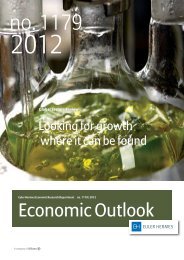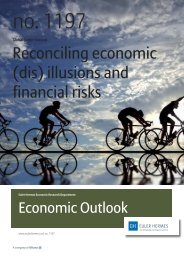Payment Periods in Europe - Euler Hermes
Payment Periods in Europe - Euler Hermes
Payment Periods in Europe - Euler Hermes
You also want an ePaper? Increase the reach of your titles
YUMPU automatically turns print PDFs into web optimized ePapers that Google loves.
Economic Outlook n° 1182 | Special Dossier | <strong>Payment</strong> periods<br />
<strong>Euler</strong> <strong>Hermes</strong><br />
The aim of this study is to provide a comparative<br />
analysis between countries (our first focus po<strong>in</strong>t)<br />
and between sectors (second focus po<strong>in</strong>t) for client<br />
and for supplier payment periods <strong>in</strong> <strong>Europe</strong>. The<br />
major f<strong>in</strong>d<strong>in</strong>gs of our study are summarised below:<br />
1The slow<strong>in</strong>g of efforts seen start<strong>in</strong>g <strong>in</strong><br />
2009 confirms the existence of three<br />
dynamics <strong>in</strong> at work <strong>in</strong> <strong>Europe</strong>.<br />
In this <strong>in</strong>itial analysis, us<strong>in</strong>g the BACH database (a<br />
<strong>Europe</strong>an database on non-f<strong>in</strong>ancial firms issued by<br />
the Bank of France), we studied the course of payment<br />
periods for several <strong>Europe</strong>an countries over the period<br />
2000-2010 (available balance sheets). We next offer<br />
a prospective view of payment periods for 2012-2013<br />
us<strong>in</strong>g <strong>Euler</strong> <strong>Hermes</strong> data, which will highlight the<br />
magnitude of the efforts that need to be made. The<br />
<strong>in</strong>dicators of change and of cash flow tensions generated<br />
put the accent on the changes and the trends<br />
<strong>in</strong> payment behaviour more than on the length of payment<br />
periods, and best reflect the risks of worsen<strong>in</strong>g<br />
cash flows that are already under pressure.<br />
> There is a clear disparity between the countries of<br />
Northern and Southern <strong>Europe</strong> that risks widen<strong>in</strong>g<br />
over the very short term (2012), <strong>in</strong> the current economic<br />
environment, and this will mean greater<br />
efforts to be made, especially for countries <strong>in</strong><br />
Southern <strong>Europe</strong>.<br />
The gaps by country. We can dist<strong>in</strong>guish <strong>in</strong> fact ‘three<br />
<strong>Europe</strong>s’: Germany and Poland, both of whom show<br />
payment periods shorter than the 60 days set out <strong>in</strong><br />
the <strong>Europe</strong>an Directive and display<strong>in</strong>g very low cash<br />
flow tension <strong>in</strong>dicators; Belgium and France with payment<br />
periods close to 60 days; and Spa<strong>in</strong>, Italy and<br />
Portugal, all of which saw significant <strong>in</strong>creases <strong>in</strong> payment<br />
periods <strong>in</strong> 2009 and will have to make considerable<br />
efforts to meet the 60-day standard.<br />
> The outlook for 2012 is for an accentuation of the<br />
gaps between countries and therefore of the efforts<br />
to be made.<br />
In 2012, payment periods should mirror economic<br />
developments. With an outlook for positive growth,<br />
payment periods for bus<strong>in</strong>esses <strong>in</strong> Poland and<br />
Germany should normally shorten by an average of 2%<br />
and 0.5% respectively. For France and Belgium, with<br />
growth forecast to be below potential, payment<br />
periods will <strong>in</strong>crease by 0.5%. By contrast, the countries<br />
most <strong>in</strong> difficulty, such as Spa<strong>in</strong>, Italy and Portugal,<br />
should see an <strong>in</strong>crease <strong>in</strong> payment periods, tak<strong>in</strong>g<br />
them further away from the 60-day target before<br />
16 March.<br />
> In 2013, a general, but limited, improvement <strong>in</strong><br />
payment periods <strong>in</strong> <strong>Europe</strong>.<br />
The outlook for positive growth <strong>in</strong> 2013 will allow an<br />
automatic improvement <strong>in</strong> payment period practices,<br />
but this will not be enough to meet the target.<br />
2 <strong>Europe</strong>an sectors: 4 groups.<br />
In a second analysis, we employ the <strong>Euler</strong> <strong>Hermes</strong><br />
database for a closer exam<strong>in</strong>ation of <strong>Europe</strong>an bus<strong>in</strong>ess<br />
sectors, over a greater number of countries. We<br />
focus on eight key sectors.<br />
> Gaps between sectors will persist, driven by the<br />
difficult economic situation and by still unequal<br />
negotiat<strong>in</strong>g strengths.<br />
There is a clear gap between sectors with<strong>in</strong> a given<br />
country and between countries <strong>in</strong> a given sector. The<br />
rank<strong>in</strong>g of sectors (by length of payment periods)<br />
rema<strong>in</strong> fairly similar from country to country. However,<br />
<strong>in</strong> Southern <strong>Europe</strong>, the sectoral differences are four to<br />
five times greater than <strong>in</strong> Northern <strong>Europe</strong>. Our eight<br />
sectors break down <strong>in</strong>to four groups: (1) air transport<br />
and automobiles, with concentrated suppliers and<br />
clients who pay quickly; (2) pharmaceuticals, chemicals<br />
and automotive components, with average payment<br />
periods s<strong>in</strong>ce they are widely present <strong>in</strong> the economy,<br />
and aeronautic component suppliers; (3) IT<br />
services, where unequal barga<strong>in</strong><strong>in</strong>g power is the rule;<br />
and (4) construction, with domestically-based suppliers<br />
and clients. ▣<br />
▶ Areas of analysis<br />
> For the first analysis:<br />
Countries: Germany, Belgium, Spa<strong>in</strong>, France,<br />
Poland, Italy and Portugal<br />
All sizes of bus<strong>in</strong>esses<br />
Period: 2000-2010<br />
> For the second analysis:<br />
Countries: Germany, Belgium, Spa<strong>in</strong>, France,<br />
Italy, United K<strong>in</strong>gdom, United States, Denmark,<br />
Norway, and Sweden.<br />
All sizes of bus<strong>in</strong>esses<br />
Period: 2006-2010<br />
Bus<strong>in</strong>ess sectors<br />
Sector Division NACE Code 1<br />
Automobiles 34 34.1 to 34.3<br />
Automotive components - 28.4<br />
Chemicals - 4.1, 24.2, 24.3, 24.5, 24.6, 24.7<br />
Pharmaceuticals - 24.4<br />
Air transport 62 62.1 and 62.2<br />
Aeronautic components - 35.3<br />
Construction - 45.2 and 45.4<br />
IT services 72 72.1 to 72.6<br />
7












